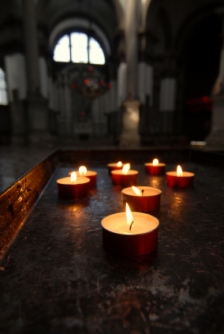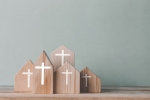March 5, 2012
Place
 Este artículo esta disponible en español aquí.
Este artículo esta disponible en español aquí.
There’s a particular scent I associate with Sunday mornings – dust and candle wax, a bit of incense, and aging wood. That was the smell I met every Sunday growing up, at St. Stephen’s, the church in San Antonio where my father was the rector. It is a small, simple building – wood, red carpet, dim light coming in through the stained glass – but it occupies an important place in my spiritual timeline.
I’ve been thinking about sacred space since St. Lydia’s, the church I currently attend, moved to a new building in Brooklyn a few months ago. St. Lydia’s is in a very different place in its life than my childhood church, which had been around for 50 years. St. Lydia’s is just two years old and without a permanent home; but for several months at least we’ll be meeting at the Brooklyn Zen Center. It has a spacious kitchen and large windows, simple furniture, and it feels clean and welcoming and sacred. The Brooklyn Zen Center has blessed us by letting us use their rooms, and is nurturing our new church (and we are helping them as well with the modest rent we pay).
Every year St. Stephen’s would also welcome others onto its property. We’d hold a garage sale where people from the neighborhood set up booths and sold videotapes, lamps and end tables, gently used T-shirts and old radios, and then they’d eat barbeque that had been smoked overnight in the parish hall (still the best brisket I can ever remember eating). During that weekend we became a visible presence in the community in a new way by opening the doors of our little church.
St. Lydia’s, on the other hand, is in the process of finding its place in the community. My time as part of this blossoming nomadic church has reminded me how important having a sacred space is, and how any space can be made sacred by the community that inhabits it. We have held services in the public spaces of Union Square, and found that even a few square feet of sidewalk can be a holy place.
Place, community, and ministry are all interwoven, and any community will do well to think of its physical space in theological terms. God’s people roamed the desert for 40 years, yes, but then they received a land of their own. God is the God of earth and heaven, stone temples, deserts, simple light-filled rooms, aging sanctuaries with red carpet, and the souls that inhabit them.
It’s useful for every community to periodically reflect on its relationship to its place (and not simply by asking whether it is time for another capital campaign): What kind of space best serves your community? Can you use your building to nurture other worthwhile organizations? Could your community survive without its building? How is your community welcoming others into its sanctuary or parish hall?





